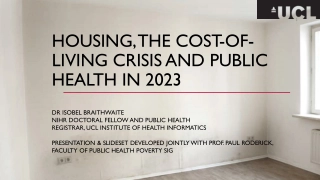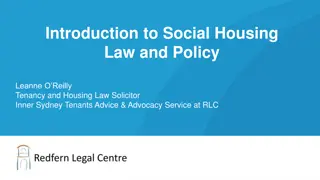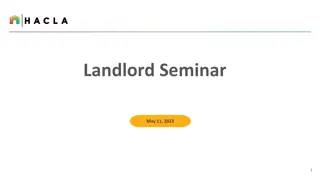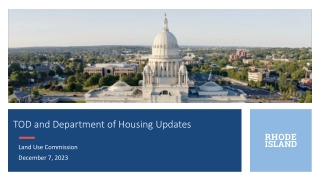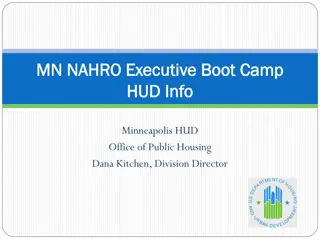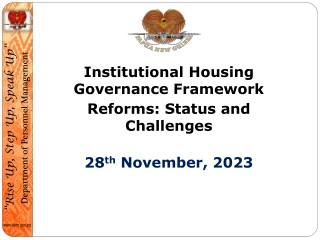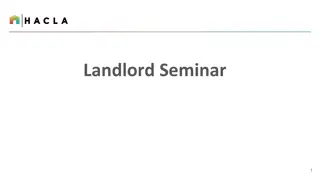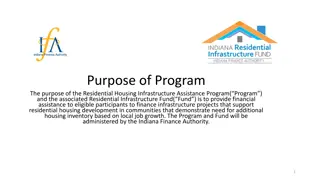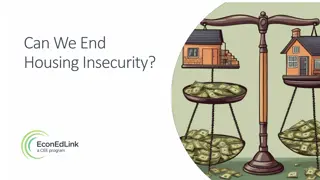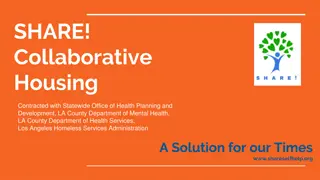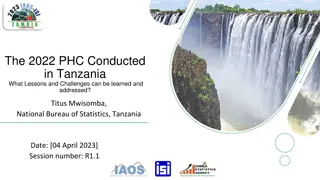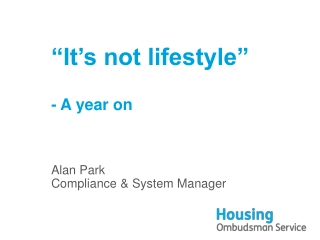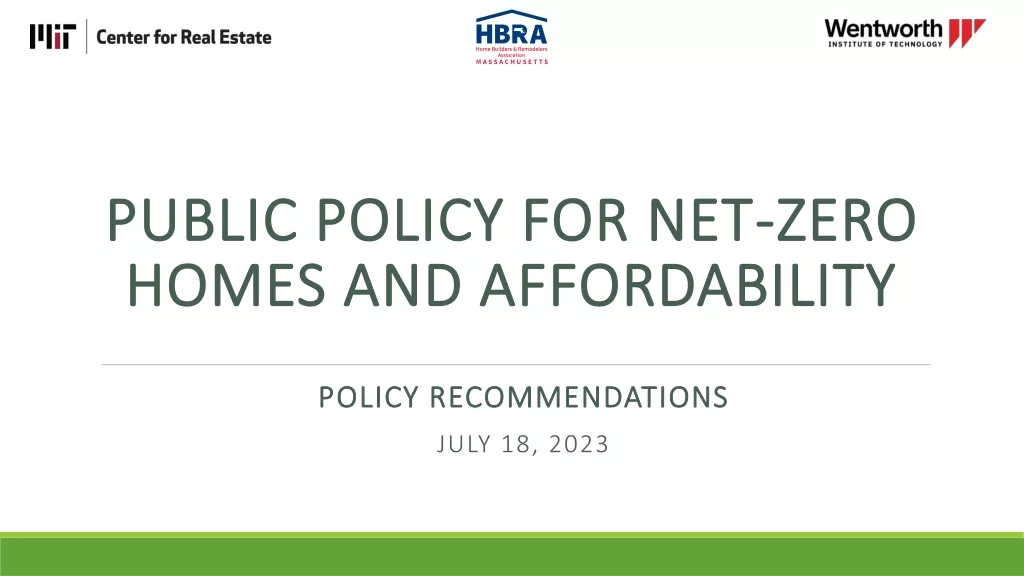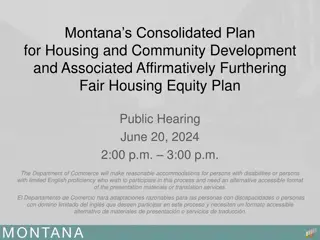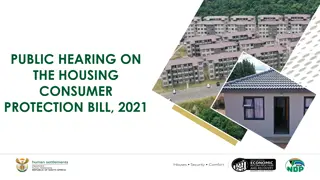Understanding CoreLogic Housing Data and Its Applications
Explore the challenges and solutions related to CoreLogic housing data, its significance in evaluating programs, how datasets are built, and current research on economic impacts using this valuable information source. Learn about CoreLogic's role as a leading provider of consumer, financial, and property data, its wide coverage range, and the diverse applications of its data across various sectors.
Download Presentation
Please find below an Image/Link to download the presentation.
The content on the website is provided AS IS for your information and personal use only. It may not be sold, licensed, or shared on other websites without obtaining consent from the author. Download presentation by click this link. If you encounter any issues during the download, it is possible that the publisher has removed the file from their server.
Presentation Transcript
CoreLogic Housing Data, Challenges and Applications to Program Evaluation
Contents Introduction to CoreLogic data Why we use this data Issues with CoreLogic data that we need to solve How we solved them
Team Neil Kattampallil: Research Scientist Aaron Schroeder: Research Associate Professor Joshua Goldstein: Research Assistant Professor Zhengyuan Zhu : Director of the Center for Survey Statistics and Methodology, Iowa State
What is CoreLogic Data Corelogic is a leading provider of consumer, financial, and property data, analytics and services to businesses and government. Their data covers over 99% of U.S. residential and commercial properties, providing insights into property valuation, risk management, and market trends. The company's data is collected from various sources including public records, proprietary databases, and partnerships with other data providers. Corelogic's data is used by mortgage lenders, real estate agents, insurance companies, and investors to make informed decisions. It s one of the biggest aggregators of real estate data in America, and has a wide coverage range, making it one of the best data sources on housing available. Photo by Marcus Lenk on Unsplash
How are these datasets built Corelogic data sets, for housing and real estate data, are built from the aggregation of public records at the county level.
What are we using this data for Recent Work: Economic Impacts of the Broadband Initiatives Program on Rural Property Prices We use proprietary real estate sales data and quasi-experimental empirical methods to account for selection to study the impacts of the Broadband Initiatives Program (BIP) established in 2009 by the American Recovery and Reinvestment Act on house sale prices. The results show that BIP broadband infrastructure projects had a positive initial and subsequent declining impact on house prices in the baseline model. These effects are robust to controlling for possible spatial spillovers of program effects to nearby properties outside of BIP project service areas. We investigated the heterogeneity of BIP impacts, finding that the short-term positive impacts are more evident for projects that provided fiber-to-the-household (FTTH) or DSL technologies than wireless projects, more evident for the least and most expensive projects in terms of cost per household than for the medium tercile, and more evident in micropolitan and metropolitan census tracts than in small town/rural census tracts Photo by Brandon Griggs on Unsplash
The Most Important pieces of Data we focus on: Property Characteristics: Sale Characteristics: Spatial information (lat/long, parcel level): Bedrooms Bathrooms Square Footage Year Built (Effective) Lot size Single Family Home(Property Type) Living Area Building Area Sale Price Sale Type (Filter out Arms Length Sales) Geolocation information Situs Address information
But why is Size really an issue? Issue 1: Size -Stata is practically limited to the amount of RAM that the machine can provide (around 16 to 32 GB of memory) while csv file sizes are routinely in the 30-40GB range. We were initially presented with the data in the form of a 2 Terabyte Main Database File, designed for use with Microsoft SQL Server. -Therefore, we use the hardware access that UVA provides (The Rivanna High-Performance Computing environment) to ingest these large data sets and split them into database tables, and then further split and collate the data by year, by state, and by county. Once unpacked, this database contained Deed data, by year, for 2005 to 2015, and Tax data split into 10 parts, devoid of any structure like state or year at the file level. - General Advice when working with CoreLogic: Ask About Data Size, Ideally, request data in 4GB chunks or smaller, so you can process them one file at a time on a laptop if needed. Request to pre-split by state and by year as your use case may be. This might result in a larger number of files, but that can be handled through code, rather than an insurmountable hardware limitation. Subsequent Data requests have thankfully been in .csv format.
In our initial data we found that the columns property_level_latitude and property_level_longitude existed in the Deed Data tables, but property characteristics (bedrooms, bathrooms, etc) existed in the Tax Data tables. Issue 2: Some Data present in Deed tables, Some data present in Tax tables To solve this, we had to join the deed and tax data tables, which is memory intensive and time- consuming. General Advice when working with CoreLogic: To give credit where due, CoreLogic has become better about making the process of joining data between Deed data ( ownertransfer ) and Tax assessment data ( propertybasic ), and you can also request specific columns of information when purchasing data. If you can, be specific about the characteristics you are specifically interested in; for reference, here is a link to a publicly accessible CoreLogic data dictionary.
Issue 3: Unique House Identifier To continue off the point introduced in the previous issue, in order to join between records in 2 tables, we needed a unique identifier that allowed us to reference a specific property. This unique identifier did not exist in the initial Corelogic data delivery. General Advice when working with CoreLogic: If purchasing new data, insist on getting the CLIP number column If working with data that has a CLIP number column, use it as a unique house identifier. If working on an older dataset that does not have a CLIP number? You will need to build a unique identifier column. Our approach was to combine the columns : This has since been rectified with the introduction of something called a CoreLogic Integrated Property Number or CLIP number fips_code (5 digit codes that represent county) and apn_parcel_number_ unformatted (Assessors Parcel Number, aka Sidewell Number aka Property Identification Number) which uniquely identifies the property in a county
In order to get a value of latitude and longitude for houses, we use the process of geocoding, which is the process of using a service to convert an address on a map to a set of co-ordinates. Issue 4: Geocoding house parcels for spatial analysis The solution we utilized was tidygeocoder , a free R library that contains a suite of tools, built by Jesse Cambon, that uses multiple geocoding services including openstreetmap and US census to find co-ordinates from a given address value. For our spatial analysis, we had to look at actual latitude and longitude level locations of properties. Additionally, the use of latitude and longitude is how we can tell if a property is within the boundaries of a BIP area or not. Since county-level data varies widely, not all counties provide co-ordinate data, thus, based on the counties you are interested in studying, you may have to use a geocoding method to obtain usable observations from the housing data. Unfortunately, several records did not have values for latitude and longitude, either for the columns property_centroid_longitude and property_centroid_latitude
In cases where total_bathrooms is missing, we need to construct total_bathrooms_calculated from multiple columns, 1qtr_baths, half_baths, 3qtr_baths, full_baths. Issue 5: Missing Data What is a bathroom? A full bathroom contains all four fixtures; a shower, a bathtub, a sink, and a toilet. A bathroom is missing one of the fixtures, either a shower or bathtub. Similar to the challenge of geocoding, occasionally there are cases where some values are simply missing from a property record. If we still don t have a value for total_bathrooms or total_bathrooms_calculated, we use web scraping methods to look up the address of the house to find number of bedrooms and number of bathrooms from sources on the internet such as Zillow or Redfin. In order to increase the number of usable observations that we have access to, we built methods to try and fill in the missing data. We focused on cases where bathroom and bedroom were missing, as these are the issues that we could try and use other data sources to fill in.
Check for general outliers and filter them out. Check the distributions of values to look at your highest values for number of bedrooms and bathrooms. If you see cases where, for instance, there are 20 bathrooms and no bedrooms, this could be a commercial property that s been mislabeled as a single-family home. If you see cases where a house has a sales price of 100$, this could be an arms-length sale or inheritance mislabeled as the wrong transaction type. Cases with 5 bedrooms but a square footage of 400 sq ft? Probably an outlier. In general, follow data cleaning best practices, as any aggregated data set can easily be affected by (usually) accidental data entry errors. Applying a statistical technique like CooksD, which looks for outliers in the relationship between multiple variables (e.g. square footage, bathroom, and bedrooms), can be very useful in filtering out true outliers. Issue 6: General errors in data entry and aggregation Even with all these layers of scrutiny, there are often cases where the numbers just don t add up. This can be attributed to the fact that these datasets are built from a large number of individual county level datasets being aggregated up to the state and national level, with almost each dataset following a different standard. Putting these datasets together is a non-trivial endeavor, and can have issues stemming from various sources including the data entry stage




